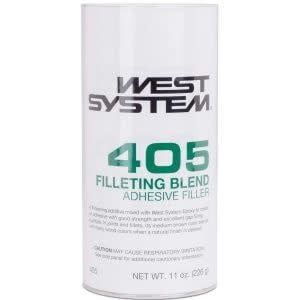West System
405 Filleting Filler (Pecan Shell Flour) 11oz
405 Filleting Filler (Pecan Shell Flour) 11oz
15 in stock
Couldn't load pickup availability
Filleting and Fairing with 405 Filleting Blend (URE-FIL™ 5)
Gluing plywood structures together with epoxy fillets saves a lot of time when making joints. It can also reduce the structural, in comparison to traditional building methods such as using wooden cleats and screws. The strength and gap-filling qualities of epoxy eliminate the need for precisely fitted wood cleats, which also require time and skill to create. When glued with conventional, non-gap filling adhesives such as resorcinol glue, wood cleats must be well fitted, and wide enough to provide sufficient gluing surface. They must also be thick enough to allow you to drive in screws.
Building with epoxy fillets is especially beneficial when attaching bulkheads to hull sides, or hull sides to hull bottoms, where the faces of the plywood come together at ever-changing angles.
Why use fillets?
When you thicken epoxy to a non-slumping consistency, it can bridge large gaps. With high-density fillers, this means you can make wood joints without sacrificing strength. This saves you time and effort in creating a strong joint.
A fillet is a continuous bead of thickened epoxy you apply to the joint angle between two parts. It increases the surface area of the bond and serves as a structural adhesive and brace. Fillets are an effective glue joint that requires no fasteners of any kind. A fillet can be just as strong as the parts it’s joining together. Using fillets saves the time and effort otherwise needed for strong, reliable joinery.
An epoxy fillet can be especially effective when you’re joining parts that meet at difficult angles. For example, where bulkheads meet the hull sides. Or where plywood hull sides meet the hull bottom. And at the chine, where hull sides meet at the bow. Also, where the hull sides join the deck at the sheer. Historically, all of these joints required well-fitted pieces of wood that could be glued and screwed into. It’s nice to know that with fillets, you don’t need to perfectly fitting joints. Compared to traditional joinery methods, fillets can also save you the expense, weight, and labor of adding screws or other fasteners—without sacrificing joint strength.
Share

- Choosing a selection results in a full page refresh.
- Opens in a new window.

